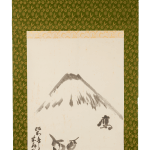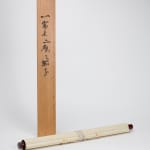Arakawa Toyozo 荒川豊蔵
H26 × W17 in.
H66.0 × W43.1 cm
Mount:
H60 × W24 1/2 in.
H152.4 × W62.2 cm
Further images
At the base of the image of Mt. Fuji, to the right, Arakawa Toyozo has written a single Kanji character “鷹” (Taka), meaning “hawk.” This painting presents a curious relationship among three traditionally auspicious and quintessentially Japanese symbols: two eggplants, one hawk, and the majestic image of Mt. Fuji looming in the background. The title of the piece, “1 Fuji, 2 Hawks, 3 Eggplants,” creates an unexpected landscape for the viewer. What is the relationship between Fuji-san, the hawks, and the eggplants? Why does the title of the work not correspond to the number of depicted images?
The mystery of these three auspicious symbols can be revealed by 初夢 (Hatsuyume), the first dream of the new year. Traditionally, the contents of such a dream are believed to foretell the luck of the dreamer in the ensuing year. Since the Edo period, it has been considered particularly good luck to dream of Mount Fuji, a hawk, and an eggplant.
This superstition in Japan is remembered in the form “Ichi-Fuji, ni-taka, san-nasubi 一富士、二鷹、三茄子, which translates to 1 Fuji, 2 Hawks, and 3 Eggplants, which is the title of this painting. Arakawa has invoked good luck through this mysterious, whimsical landscape of a dream.
The scroll is signed 斗出庵 Tosyutuan*
*Note: Arakawa Toyozo had begun using the two "Literati" or artists names 無田陶人 Muta Tojin and 斗出庵 Tosyutuan after 1972.









